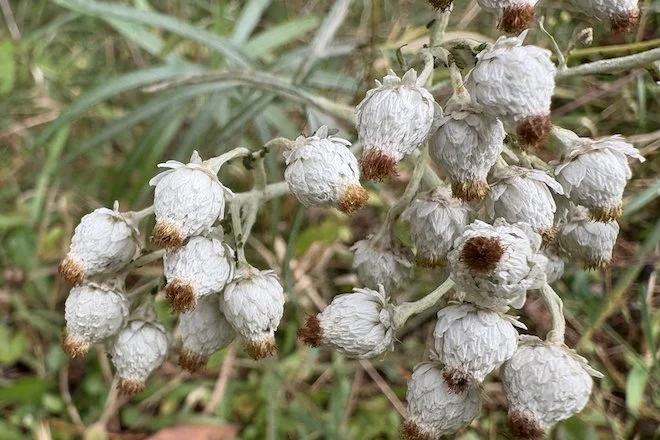This week: Pearly Everlasting Outlasts the Fall
Hello!
Now that fall is underway, Goldenrods and Asters are dotting the landscape. But, don’t overlook another fall bloomer that also happens to be in the Aster family, Pearly Everlasting (Anaphalis margaritacea). In the wild, you might spot this plant along roadsides and cut edges of woods, as it tolerates full sun to part shade and will grow in dry, gravelly conditions. The white flowerhead and silvery foliage make it stand out, even though it is relatively short at just two to three feet tall.

The weird thing about Pearly Everlasting is its flower. It’s small and yellow. The much-admired white “pearl” part is actually its bracts (this is the same as Flowering Dogwoods—the white or pink petals are bracts, while the center is the flower). The Pearly Everlasting pictured above has finished blooming—the brownish spot in the center is the remnants of its yellow, tubular flowers. Pearly Everlasting is often picked before it blooms, when the “flower” is totally white, as it is popular in cut flower arrangements and holds up well when dried.
Like so many native plants, it was used medicinally by indigenous peoples, but it also held ceremonial or spiritual significance for some. The Potawatomi, originally inhabiting the Great Lakes region, burned the flowers for protection against evil spirits. The Cheyenne, also originally from the Great Lakes, used it ceremonially to strengthen warriors and purify gifts made to spirits.
If you’re a fan of butterflies, you might want to find a home in your garden for Pearly Everlasting: it’s a larval host plant and adult food source for the Painted Lady and American Lady butterflies.
Elsewhere:
In this story of a Wisconsin monastery gone wild, the sisters who reside there have made it their mission to restore the 170 acres where they live to native prairies and savannahs, which is now home to more than 132 species of birds and the endangered rusty-patched bumblebee. Read more about it in this gift article from The New York Times.
Have a great week,
Julie